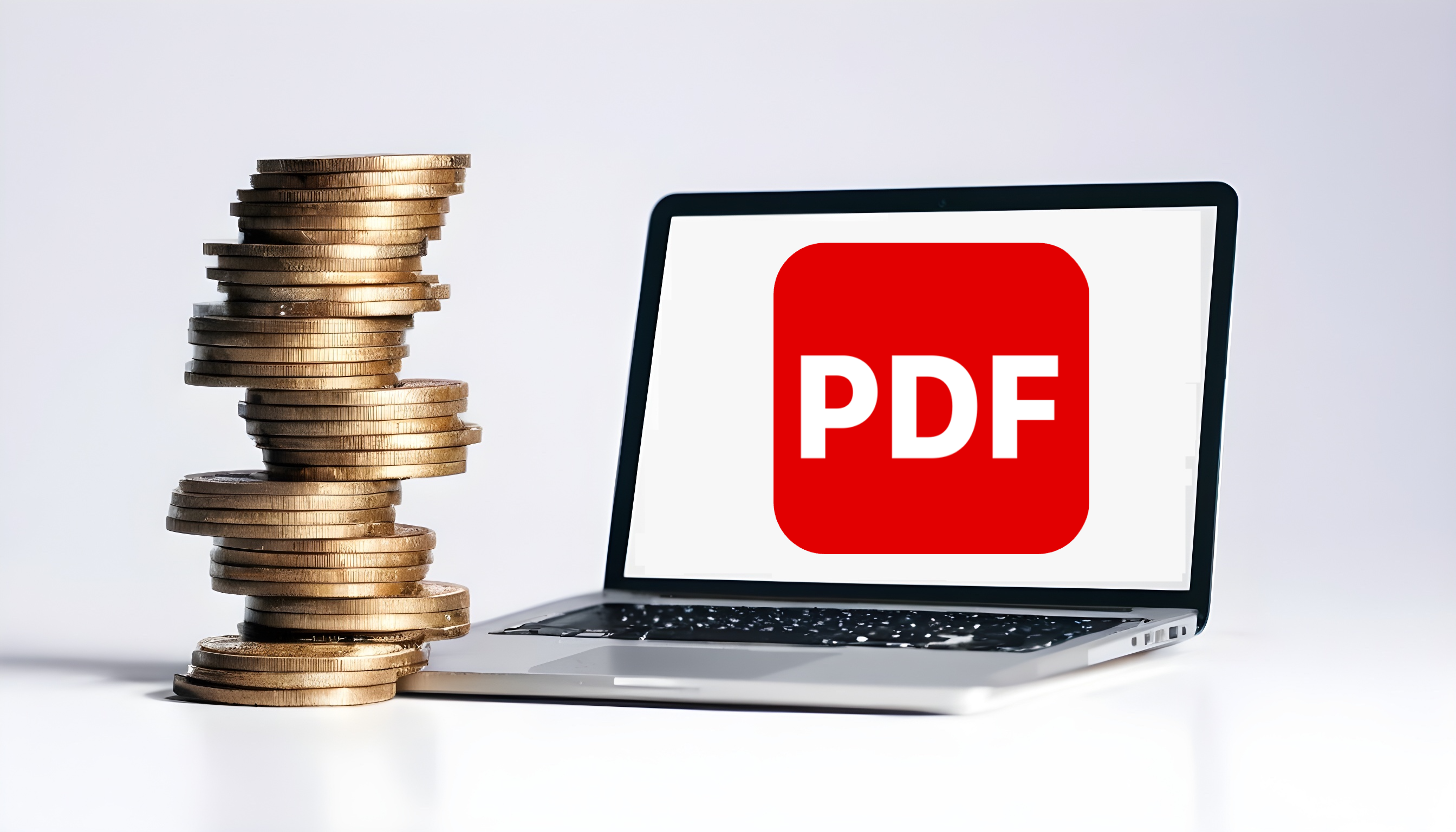E-invoicing: Five ways your PDFs are costing you money
-
02 Apr, 2024
-
4 min read

As the tech landscape evolves and the market for automated solutions rapidly increases, it's no surprise that manual processes are getting an increasingly worse reputation.
Although we tip our hats to the elbow grease that got many of us to where we are today, clinging to archaic processes is a lot like driving a car while only looking in the rear-view mirror—difficult and risky.
However, the narrative around manual processes often implies that all challenges derive from using paper-based processes and storing heaps of files in a cabinet. This is not the case, especially when it comes to AR.
Do PDFs still count as 'manual' processes?
When referring to 'manual processes,' we first need to establish that this includes PDFs. Yes, they count as digitised invoicing processes, but they are still far removed from AR automation and e-invoicing solutions.
Sorry, PDFs, but you don't make the cut. Moreover, if your company still uses spreadsheets and collects AR manually, or you're still sending manual payment emails, we're talking to you.
The difference between PDFs and e-invoices
In brief, PDF invoices are digital files that replicate the layout and content of a traditional paper invoice. An e-invoice, on the other hand, carries much more significance and value.
It represents a more advanced and automated approach to invoicing. It leverages structured data formats and electronic exchange systems to streamline the entire invoicing process. What does this mean for businesses that are still using PDFs?
Five ways PDFs are hurting you financially
1. Higher DSO and suboptimal customer experience
When working with PDFs, although digital, it still requires a significant amount of manual intervention for customers to process and approve payments. Clients have to spend a lot of time capturing your PDF data manually, resulting in longer processing and approval times, poorer customer experience, and late payments.
2. Poor resource allocation
In a recent piece by The Raconteur, data shows that up to 56.4 million hours are spent chasing overdue payments each year, and this time would be better spent on higher-value finance tasks related to data analysis or financial reporting.
As PDFs perpetuate the common bottlenecks within the AR collaboration process, critical resources are often allocated to resource-intensive and time-consuming tasks such as updating records, calling customers, emailing invoices, and maintaining spreadsheets that can otherwise be automated.
3. Opportunity costs
If businesses still rely on manual invoicing processes, including PDFs, they are essentially bypassing the significant growth opportunities that come from e-invoicing solutions. As the company grows, manual processes become increasingly inefficient and difficult to scale, potentially hindering expansion. As the widespread adoption of e-invoicing solutions continues to scale, businesses may miss out on partnerships due to incompatible invoicing systems.
4. A lack of real-time data
PDFs don't have data transfer capabilities—or at least not much more than a paper-based invoice. This makes it challenging to gather and analyse data related to invoicing, such as payment trends, customer behaviour, and revenue forecasting. This lack of insight can hinder strategic decision-making and limit the business's ability to optimise its invoicing and revenue management processes.
5. The cost of non-compliance
E-invoicing is fast-moving from what was once considered a novelty to more of a necessity. This is particularly true considering recent updates from government authorities like SARS discussing a mandatory move towards VAT modernisation and likely e-invoicing - similar to VAT modernisation efforts being adopted by tax authorities all over the world. Failure to comply in the near future could lead to potential non-compliance fees and leave your business open to exposure.
An effortless transition with System1A
Fortunately, you don't have to rely on manual processes like PDFs to get the job done—at least not with us in your corner. We provide one application to manage all your company's accounts, communications, deliveries, interactions, payments, receipts, and reporting.
Watch our overview video here
Although we tip our hats to the elbow grease that got many of us to where we are today, clinging to archaic processes is a lot like driving a car while only looking in the rear-view mirror—difficult and risky.
However, the narrative around manual processes often implies that all challenges derive from using paper-based processes and storing heaps of files in a cabinet. This is not the case, especially when it comes to AR.
Do PDFs still count as 'manual' processes?
When referring to 'manual processes,' we first need to establish that this includes PDFs. Yes, they count as digitised invoicing processes, but they are still far removed from AR automation and e-invoicing solutions.
Sorry, PDFs, but you don't make the cut. Moreover, if your company still uses spreadsheets and collects AR manually, or you're still sending manual payment emails, we're talking to you.
The difference between PDFs and e-invoices
In brief, PDF invoices are digital files that replicate the layout and content of a traditional paper invoice. An e-invoice, on the other hand, carries much more significance and value.
It represents a more advanced and automated approach to invoicing. It leverages structured data formats and electronic exchange systems to streamline the entire invoicing process. What does this mean for businesses that are still using PDFs?
Five ways PDFs are hurting you financially
1. Higher DSO and suboptimal customer experience
When working with PDFs, although digital, it still requires a significant amount of manual intervention for customers to process and approve payments. Clients have to spend a lot of time capturing your PDF data manually, resulting in longer processing and approval times, poorer customer experience, and late payments.
2. Poor resource allocation
In a recent piece by The Raconteur, data shows that up to 56.4 million hours are spent chasing overdue payments each year, and this time would be better spent on higher-value finance tasks related to data analysis or financial reporting.
As PDFs perpetuate the common bottlenecks within the AR collaboration process, critical resources are often allocated to resource-intensive and time-consuming tasks such as updating records, calling customers, emailing invoices, and maintaining spreadsheets that can otherwise be automated.
3. Opportunity costs
If businesses still rely on manual invoicing processes, including PDFs, they are essentially bypassing the significant growth opportunities that come from e-invoicing solutions. As the company grows, manual processes become increasingly inefficient and difficult to scale, potentially hindering expansion. As the widespread adoption of e-invoicing solutions continues to scale, businesses may miss out on partnerships due to incompatible invoicing systems.
4. A lack of real-time data
PDFs don't have data transfer capabilities—or at least not much more than a paper-based invoice. This makes it challenging to gather and analyse data related to invoicing, such as payment trends, customer behaviour, and revenue forecasting. This lack of insight can hinder strategic decision-making and limit the business's ability to optimise its invoicing and revenue management processes.
5. The cost of non-compliance
E-invoicing is fast-moving from what was once considered a novelty to more of a necessity. This is particularly true considering recent updates from government authorities like SARS discussing a mandatory move towards VAT modernisation and likely e-invoicing - similar to VAT modernisation efforts being adopted by tax authorities all over the world. Failure to comply in the near future could lead to potential non-compliance fees and leave your business open to exposure.
An effortless transition with System1A
Fortunately, you don't have to rely on manual processes like PDFs to get the job done—at least not with us in your corner. We provide one application to manage all your company's accounts, communications, deliveries, interactions, payments, receipts, and reporting.
Watch our overview video here
Related insights





